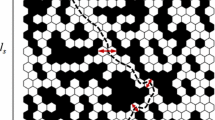Abstract
It is shown, from a study of geometric probabilities, that the average number of intercepts per unit length of a random line drawn through a three-dimensional structure is exactly half the true ratio of surface to volume. Since the surfaces can be internal or external, the area of grain boundary or of the interface between any two constituents in a microstructure can be measured. Other metric relations are tabulated that may be of use in studies of the microstructure of polycrystalline, cellular, or particulate matter generally.
Similar content being viewed by others
References
Cyril Stanley Smith: Grain Shapes and Other Metallurgical Applications of Topology. Paper in Metal Interfaces (1952) pp. 65–113. Cleveland. ASM.
ASTM Classification of Grain Size in Steels, ASTM (a) Tentative Standard E-19-39T. (b) Preparation of Micrographs of Metals and Alloys (Including Grain Size Standards for Non-Ferrous Metals), ASTM Standard E2-44T.
E. Scheil: Statistical Investigations of the Structures of Alloys. Ztsch. Metallkunde (1935) 27, pp. 199–208; (1936) 28, pp. 340-343.
W. A. Johnson: Estimation of Spatial Grain Size. Metal Progress (1946) 49, (1), pp. 89–92.
J. B. Rutherford, R. H. Aborn, and E. C. Bain: Relation of Grain Area on a Plane Section and the Grain Size of a Metal. Metals and Alloys (1937) 8, pp. 345–348; ASM Metals Handbook (1948) p. 405.
R. T. Roward and Morris Cohen: Quantitative Metallography by Point-Counting and Lineal Analysis. Trans. AIME (1947) 172, pp. 413–426; Metals Technology (August 1947).
Emanuel Czuber: Geometrische Wahrscheinlichkeiten und Mittelwerte (1884) Leipzig. B. G. Teubner.
C. S. Hurlburt: An Electric Counter for Thin Section Analysis. American Journal of Science (1939) 237, p. 253.
C. K. Wentworth: An Improved Recording Micrometer for Rock Analysis. Journal of Geology (1923) 31, p. 228.
Lilian Reikkinen Beck and Cyril Stanley Smith: The Copper-Zinc Constitution Diagram, Redetermined in the Vicinity of the Beta Phase by Means of Quantitative Metallography. Trans. AIME (1952) 194, pp. 1079–1083; Journal of Metals (October 1952).
F. Chayes: A Simple Point Counter for Thin Section Analysis. American Minerologist (1949) 34, pp. 1–11, 600-601.
Author information
Authors and Affiliations
Additional information
Discussion on this paper, TP 3430E, may be sent, 2 copies, to AIME by March 1, 1953. Manuscript, April 16, 1952.
Rights and permissions
About this article
Cite this article
Smith, C.S., Guttman, L. Measurement of Internal Boundaries in Three-Dimensional Structures By Random Sectioning. JOM 5, 81–87 (1953). https://doi.org/10.1007/BF03397456
Published:
Issue Date:
DOI: https://doi.org/10.1007/BF03397456




